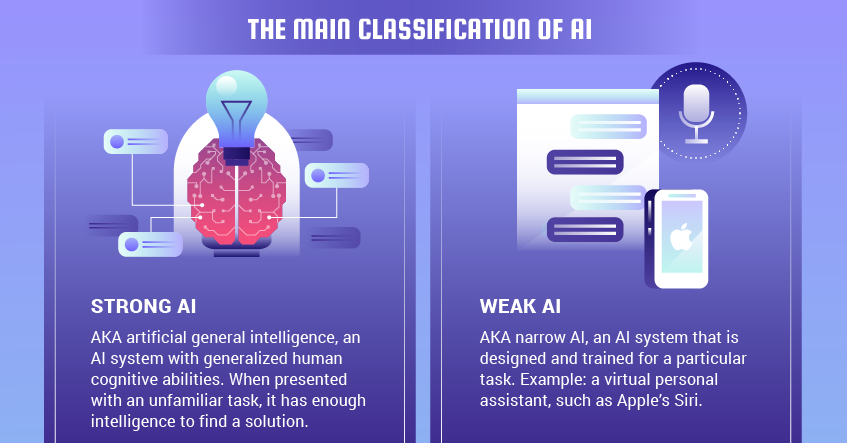Technology
Visualizing the AI Revolution in One Infographic
Science fiction didn’t do a great job in preparing us for our first real encounters with AI.
Most people probably still envision AI in the form of a sentient robot that can talk, move around, and experience feelings – something like WALL-E or C-3PO from the movies.
Although that still may be the dream, it turns out that the current iteration of AI is actually quite different. With modern AI, all the “thinking” gets done in the cloud, and the algorithms aren’t tied to the identity of a physical machine like we would have expected from the big screen.
The modern iteration of AI works silently in the background without a face, and it’s starting to impact everything it touches. It’s also set to transform our economy at warp speed.
Putting Modern AI Into Context
Today’s infographic from TechJury helps you understand the context around this emerging force.
Entitled “The AI Revolution”, it covers the brief history of AI, the industries that will be affected, as well as some key AI statistics that are likely to catch your eye.

Note: The infographic references a chatbot named Eugene Goostman that allegedly passed the Turing Test in 2014. Please note that this is a very contentious claim: while it did fool 33% of judges that it was a human, many experts object to the claim for a wide variety of reasons.
Artificial intelligence is here and it’s transforming our economy.
One estimate by PwC puts the global impact of AI at $15.7 trillion by 2030, while Accenture says that AI could double the rate of economic growth in developed countries by 2035.
If either of these two predictions come true, it will mean big change for almost every industry.
The AI Revolution: By the Numbers
What does it look like when AI takes the world be storm?
The following stats will give you an indication on the potential impact of the AI revolution, and how it’s already shaping the future of business thinking:
- The number of AI startups has increased 14x since the year 2000
- The amount of investment in AI startups has increased 6x since 2000
- 15% of enterprises in 2018 already use AI, but 31% more will come on board in the next 12 months
- 72% of executives see AI as being the most significant future business advantage
- 84% of global businesses see AI as providing a competitive advantage
- 41% of consumers believe AI will improve their lives in some way
- By 2020, businesses using AI to drive consumer insights will see $1.2 trillion more per year than their less-informed competitors
So while the AI revolution is not led by the identifiable face of a friendly (or antagonistic) robot in a physical form, experts agree that impact of AI on business will be profound.
See how the prevailing myths about AI in the workplace have been debunked, to learn even more on the subject.
Technology
Visualizing AI Patents by Country
See which countries have been granted the most AI patents each year, from 2012 to 2022.

Visualizing AI Patents by Country
This was originally posted on our Voronoi app. Download the app for free on iOS or Android and discover incredible data-driven charts from a variety of trusted sources.
This infographic shows the number of AI-related patents granted each year from 2010 to 2022 (latest data available). These figures come from the Center for Security and Emerging Technology (CSET), accessed via Stanford University’s 2024 AI Index Report.
From this data, we can see that China first overtook the U.S. in 2013. Since then, the country has seen enormous growth in the number of AI patents granted each year.
| Year | China | EU and UK | U.S. | RoW | Global Total |
|---|---|---|---|---|---|
| 2010 | 307 | 137 | 984 | 571 | 1,999 |
| 2011 | 516 | 129 | 980 | 581 | 2,206 |
| 2012 | 926 | 112 | 950 | 660 | 2,648 |
| 2013 | 1,035 | 91 | 970 | 627 | 2,723 |
| 2014 | 1,278 | 97 | 1,078 | 667 | 3,120 |
| 2015 | 1,721 | 110 | 1,135 | 539 | 3,505 |
| 2016 | 1,621 | 128 | 1,298 | 714 | 3,761 |
| 2017 | 2,428 | 144 | 1,489 | 1,075 | 5,136 |
| 2018 | 4,741 | 155 | 1,674 | 1,574 | 8,144 |
| 2019 | 9,530 | 322 | 3,211 | 2,720 | 15,783 |
| 2020 | 13,071 | 406 | 5,441 | 4,455 | 23,373 |
| 2021 | 21,907 | 623 | 8,219 | 7,519 | 38,268 |
| 2022 | 35,315 | 1,173 | 12,077 | 13,699 | 62,264 |
In 2022, China was granted more patents than every other country combined.
While this suggests that the country is very active in researching the field of artificial intelligence, it doesn’t necessarily mean that China is the farthest in terms of capability.
Key Facts About AI Patents
According to CSET, AI patents relate to mathematical relationships and algorithms, which are considered abstract ideas under patent law. They can also have different meaning, depending on where they are filed.
In the U.S., AI patenting is concentrated amongst large companies including IBM, Microsoft, and Google. On the other hand, AI patenting in China is more distributed across government organizations, universities, and tech firms (e.g. Tencent).
In terms of focus area, China’s patents are typically related to computer vision, a field of AI that enables computers and systems to interpret visual data and inputs. Meanwhile America’s efforts are more evenly distributed across research fields.
Learn More About AI From Visual Capitalist
If you want to see more data visualizations on artificial intelligence, check out this graphic that shows which job departments will be impacted by AI the most.
-

 Mining1 week ago
Mining1 week agoGold vs. S&P 500: Which Has Grown More Over Five Years?
-

 Markets2 weeks ago
Markets2 weeks agoRanked: The Most Valuable Housing Markets in America
-

 Money2 weeks ago
Money2 weeks agoWhich States Have the Highest Minimum Wage in America?
-

 AI2 weeks ago
AI2 weeks agoRanked: Semiconductor Companies by Industry Revenue Share
-

 Markets2 weeks ago
Markets2 weeks agoRanked: The World’s Top Flight Routes, by Revenue
-

 Countries2 weeks ago
Countries2 weeks agoPopulation Projections: The World’s 6 Largest Countries in 2075
-

 Markets2 weeks ago
Markets2 weeks agoThe Top 10 States by Real GDP Growth in 2023
-

 Demographics2 weeks ago
Demographics2 weeks agoThe Smallest Gender Wage Gaps in OECD Countries














